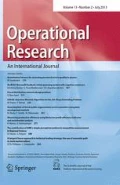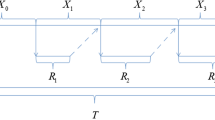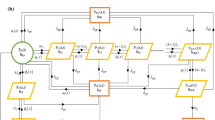Abstract
In this paper, we propose a new repair model for a cold standby system, which consists of two components and one repairman. It is assumed that the consecutive working time follows decreasing geometric process after repair, and the repair time interval is a constant for component 1. For component 2 (standby component), the failure process during working time follows Generalized Polya Process, which is a generalized version of the nonhomogeneous Poisson process. Component 2 is rectified by Generalized Polya Process repair when it fails. The repair time of component 2 is assumed to be negligible. Component 1 is assumed to have priority in use. The long-run average cost rate function of the system is deduced based on the failure number of component 1. Moreover, the optimal replacement policy of model is established by minimizing the long-run average cost rate function theoretically, which proves the existence and uniqueness of the optimal replacement policy. Numerical examples are provided to verify the effectiveness of the proposed approaches. Sensitivity analysis are conducted to illustrate the influence of parameters under the optimal replacement policy.






Similar content being viewed by others
References
Avenab T (2008) A minimal repair replacement model with two types of failure and a safety constraint. Eur J Oper Res 188(2):506–515
Barlow R, Hunter L (1960) Optimum preventive maintenance policies. Oper Res 8(1):90–100
Braun WJ, Li W, Zhao YQ (2005) Properties of the geometric and related processes. Naval Res Logist (NRL) 52(7):607–616
Brown M, Proschan F (1983) Imperfect repair. J Appl Probab 20(4):851–859
Berrade M, Scarf PA, Cavalcante CAV (2017) A study of postponed replacement in a delay time model. Reliab Eng Syst Saf 168:70–79
Cha JH (2014) Characterization of the generalized polya process and its applications. Adv Appl Probab 46(4):1148–1171
Cha JH, Finkelstein M (2009) On a terminating shock process with independent wear increments. J Appl Probab 46(2):353–362
Cha JH, Finkelstein M (2011) On new classes of extreme shock models and some generalizations. J Appl Probab 48(1):258–270
Cha JH, Finkelstein M (2018) On information-based residual lifetime in survival models with delayed failures. Stat Probab Lett 137:209–216
Chan JS, Yu PL, Lam Y, Ho AP (2006) Modelling SARS data using threshold geometric process. Stat Med 25(11):1826–1839
Chen M, Zhao XF, Nakagawa T (2019) Replacement policies with general models. Ann Oper Res 277(1):47–61
Finkelstein MS (1993) A scale model of general repair. Microelectron Reliab 33(1):41–44
Ito K, Zhao XF, Nakagawa T (2017) Random number of units for k-out-of-n systems. Appl Math Model 45:563–572
Jaturonnateeaba J (2006) Optimal preventive maintenance of leased equipment with corrective minimal repairs. Eur J Oper Res 174(1):201–215
Lam Y (1988a) Geometric processes and replacement problem. Acta Math Appl Sin 4:366–377
Lam Y (1988b) A note on the optimal replacement problem. Adv Appl Probab 20(2):479–482
Lam Y (2007) The geometric process and its applications. World Scientific, Singapore
Lee H, Cha JH (2016) New stochastic models for preventive maintenance and maintenance optimization. Eur J Oper Res 255(1):80–90
Levitin G, Finkelstein M (2019) Optimal loading of elements in series systems exposed to external shocks. Reliab Eng Syst Saf. https://doi.org/10.1016/j.ress.2017.08.009
Levitin G, Finkelstein M, Dai Y (2018) Optimizing availability of heterogeneous standby systems exposed to shocks. Reliab Eng Syst Saf 170:137–145
Lim JH, Qu J, Zuo MJ, Soares CG (2016) Age replacement policy based on imperfect repair with random probability. Reliab Eng Syst Saf 149:24–33
Nakagawa T (1986) Periodic and sequential preventive maintenance policies. J Appl Probab 23(2):536–542
Ross SM (1996) Stochastic processes, 2nd edn. Wiley, New York
Sheu SH, Li SH (2012) A generalised maintenance policy with age-dependent minimal repair cost for a system subject to shocks under periodic overhaul. Int J Syst Sci 43(6):1007–1013
Sheu SH, Chen YL, Chang CC, Zhang ZG (2016) A note on a two variable block replacement policy for a system subject to non-homogeneous pure birth shocks. Appl Math Model 40:3703–3712
Smith WL, Leadbetter MR (1963) On the renewal function for the Weibull distribution. Technometrics 5(3):393–396
Stadje W, Zuckerman D (1990) Optimal strategies for some repair replacement models. Adv Appl Probab 22(3):641–656
Tsai HN, Sheu SH, Zhang ZG (2017) A trivariate optimal replacement policy for a deteriorating system based on cumulative damage and inspections. Reliab Eng Syst Saf 160:74–88
Wang GJ, Zhang YL (2011) A bivariate optimal replacement policy for a cold standby repairable system with preventive repair. Appl Math Comput 218(7):3158–3165
Wang GJ, Zhang YL (2016) Optimal replacement policy for a two-dissimilar-component cold standby system with different repair actions. Int J Syst Sci 47(5):1021–1031
Wu S (2018) Doubly geometric processes and applications. J Oper Res Soc 69(1):66–77
Wu S, Wang G (2017) The semi-geometric process and some properties. IMA J Manag Math 29(2):229–245
Zhang YL (1994) A bivariate optimal replacement policy for a repairable system. J Appl Probab 31(4):1123–1127
Zhang YL, Wang GJ (2007) A deteriorating cold standby repairable system with priority in use. Eur J Oper Res 183(1):278–295
Zhang YL, Wang GJ (2009) A geometric process repair model for a repairable cold standby system with priority in use and repair. Reliab Eng Syst Saf 94(11):1782–1787
Zhang YL, Wang GJ (2016) An extended geometric process repair model for a cold standby repairable system with imperfect delayed repair. Int J Syst Sci Oper Logist 3(3):163–175
Zhao XF, Nakagawa T (2012) Optimization problems of replacement first or last in reliability theory. Eur J Oper Res 223:141–149
Zhao XF, Al-Khalifa KN, Nakagawa T (2015) Approximate methods for optimal replacement, maintenance, and inspection policies. Reliab Eng Syst Saf 144:68–73
Zhao XF, Al-Khalifa KN, Hamouda AM, Nakagawa T (2017a) Age replacement models: a summary with new perspectives and methods. Reliab Eng Syst Saf 161:95–105
Zhao XF, Qian CH, Nakagawa T (2017b) Comparisons of replacement policies with periodic times and repair numbers. Reliab Eng Syst Saf 168:161–170
Acknowledgements
This work was supported by National Natural Science Foundation of China under Grant number [61573014] and the Fundamental Research Funds for the Central Universities of China under Grant number [JB180702]. The authors would like to thank the editor and the anonymous referees for the valuable suggestions that improved the quality of this paper.
Author information
Authors and Affiliations
Corresponding author
Additional information
Publisher's Note
Springer Nature remains neutral with regard to jurisdictional claims in published maps and institutional affiliations.
This work was supported by National Natural Science Foundation of China [Grant number 61573014] and the Fundamental Research Funds for the Central Universities of China [Grant Number JB180702].
Rights and permissions
About this article
Cite this article
Wang, J., Ye, J. A new repair model and its optimization for cold standby system. Oper Res Int J 22, 105–122 (2022). https://doi.org/10.1007/s12351-020-00545-x
Received:
Revised:
Accepted:
Published:
Issue Date:
DOI: https://doi.org/10.1007/s12351-020-00545-x




